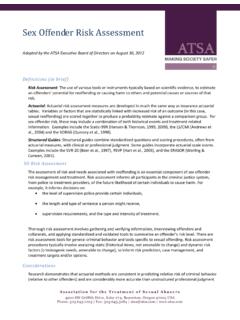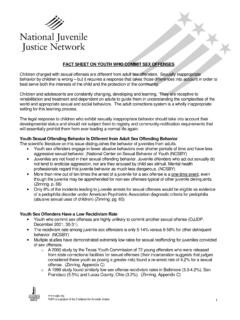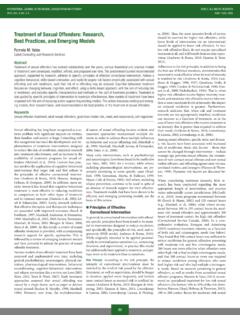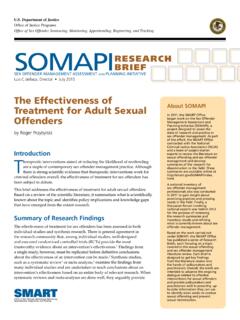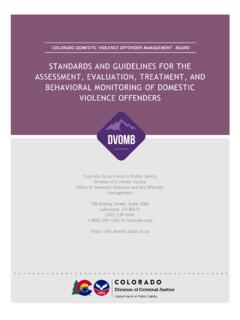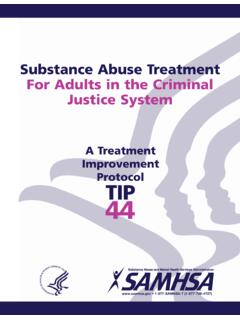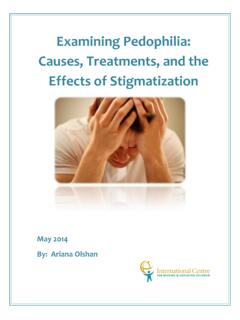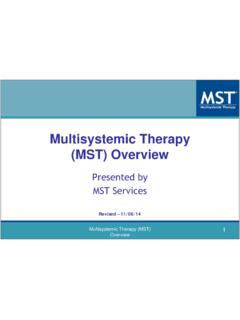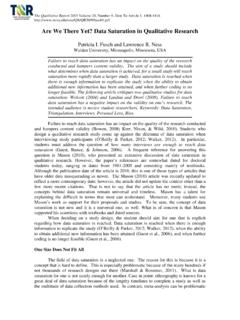Transcription of Sex Offender Risk Assessment - ATSA
1 A s s o c i a t i o n f o r t h e T r e a t m e n t o f S e x u a l A b u s ers 4900 SW Griffith Drive, Suite 274, Beaverton, Oregon 97005 USA Phone: | Fax: | | Sex Offender Risk Assessment Adopted by the ATSA Executive Board of Directors on August 30, 2012 Definitions (in brief ) Risk Assessment : The use of various tools or instruments typically based on scientific evidence, to estimate an offenders potential for reoffending or causing harm to others and potential causes or sources of that risk. Actuarial: Actuarial risk Assessment measures are developed in much the same way as insurance actuarial tables. Variables or factors that are statistically linked with increased risk of an outcome (in this case, sexual reoffending) are scored together to produce a probability estimate against a comparison group. For sex Offender risk, these may include a combination of both historical events and treatment -related information.
2 Examples include the Static-99R (Hanson & Thornton, 1999; 2009), the LS/CMI (Andrews et al., 2004) and the SORAG (Quinsey et al., 1998). Structured Guides: Structured guides combine standardized questions and scoring procedures, often from actuarial measures, with clinical or professional judgment. Some guides incorporate actuarial scale scores. Examples include the SVR-20 (Boer et al., 1997), RSVP (Hart et al., 2003), and the ERASOR (Worling & Curwen, 2001). SO Ri sk A sses sment The Assessment of risk and needs associated with reoffending is an essential component of sex Offender risk management and treatment . Risk Assessment informs all participants in the criminal justice system, from police to treatment providers, of the future likelihood of certain individuals to cause harm. For example, it informs decisions on the level of supervision police provide certain individuals, the length and type of sentence a person might receive, supervision requirements, and the type and intensity of treatment .
3 Thorough risk Assessment involves gathering and verifying information, interviewing offenders and collaterals, and applying standardized and validated tools to summarize an Offender s risk level. There are risk Assessment tools for general criminal behavior and tools specific to sexual offending. Risk Assessment procedures typically involve analyzing static (historical items, not amenable to change) and dynamic risk factors (criminogenic needs, amenable to change), to inform risk prediction, case management, and treatment targets and/or options. Considerations research demonstrates that actuarial methods are consistent in predicting relative risk of criminal behavior (relative to other offenders) and are considerably more accurate than unstructured professional judgment for sexual , violent, or other recidivism (Hanson & Morton-Bourgon, 2009).
4 Reminiscent of all of the important research in applied fields, there has been significant debate in this area. For example, Walters and colleagues (2009) identified three main critiques of sexual Offender actuarial risk measures: (a) that they are based on previously measured variables (such as age, number of victims, and so on) instead of theory, (b) that base rates vary due to updated information on offense type, recidivism definition, and follow up periods, and (c) that these measures are sometimes used on different populations than were part of the original development sample. These and other questions such as which instrument to use when, the stability of absolute recidivism rates, and whether specific subgroups have unique risk factors not yet addressed in established risk Assessment tools, are the current focus of research in this area.
5 Due to the heterogeneity of these clients, no one tool has proved superior to the others in terms of predictive accuracy. research on risk Assessment , cultural and ethnicity differences, and specific subgroups such as mentally disordered and/or intellectually disabled offenders is ongoing. Preliminary research in these areas suggests that some of the current tools may apply, but must be used with caution (Craig, 2010). research findings on structured guides is promising, but still in its formative years. Current research H ig hlight s The development and validation of risk Assessment tools is regularly evolving, building on the need for improved predictive accuracy, utility, and integration with case-management. Due to this increased need and attention, there are many thoughtful and thorough articles. The following list highlights a few of the different topics under evaluation and applicable recent publications (for full listing of the articles, see the bibliography): Underlying theories and the nature of development: Harris & Hanson, 2010; Andrews & Bonta, 2010.
6 Risk Assessment and potential impacts on human rights: Vess, 2008 best practices for understanding and utilizing risk assessments: Kemshall, 2011; Craig & Beech, 2009 Examples of research on risk and specific subgroups: Babchishin, Blais, & Helmus (2012); Craig, 2010 Comparing risk measures: Looman & Abracen, 2010; Hanson & Morton-Bourgon, 2009; Quinsey, Harris, Rice, & Cormier, 2006; Knight & Thornton, 2007; Langton et al 2007. What Promotes Suc ce ssful Risk As sess ment? As stated previously, risk Assessment informs all participants in the criminal justice system, from police to treatment providers, of the risk and needs associated reoffending, to inform case management. To ensure appropriate application and scoring of risk Assessment tools and limit the rate of false positive or negative predictions, Craig & Beech (2009) recommend that practitioners know the methodology underlying the tools as well as possible application errors.
7 The authors suggest that best practice involves the understanding of risk Assessment concepts and factors known to affect actuarial estimates, such as low base rates, age, and downgrading of charges. Harris & Hanson (2010) emphasize the need for quality control of these tools and their application through regular structured discussions such as peer reviews and mentorships. Summary The prediction of reoffending is an essential component of sex Offender risk management and treatment . The ongoing development and validation of risk Assessment tools speaks to the necessity of using current evidence-based measures in a highly litigious area. In addition, the application of these tools requires rigor and ongoing support. Additional Resour ces A s s o c i a t i o n f o r t h e T r e a t m e n t o f S e x u a l A b u s e r s 4900 SW Griffith Drive, Suite 274, Beaverton, Oregon 97005 USA Phone: | Fax: | | Adult Male Sex Offender Risk Assessment Selected Bibliography Note: This bibliography is not intended to be an exhaustive review of the area, but rather a list of research articles and books that focus on many of the various aspects of risk Assessment .
8 Amirault, J., & Lussier, P. (2011). Population heterogeneity, state dependence and sexual Offender recidivism: The aging process and the lost predictive impact of prior criminal charges over time. Journal Of Criminal Justice, 39(4), 344-354. Andrews, D. A., & Bonta, J. (2010a). The psychology of criminal conduct (5th ed.). New Providence, NJ: LexisNexis Anderson, D., & Hanson, R. K. (2010). Static-99: An actuarial tool to assess risk of sexual and violent recidivism among sexual offenders. In R. K. Otto, K. S. Douglas (Eds.) , Handbook of violence risk Assessment (pp. 251-267). New York, NY US: Routledge/Taylor & Francis Group. Babchishin, K. M., Blais, J., & Helmus, L. (2012). Do Static Risk Factors Predict Differently for Aboriginal Sex Offenders? A Multi-site Comparison Using the Original and Revised Static-99 and Static-2002 Scales. Canadian Journal Of Criminology & Criminal Justice, 54(1), 1-43.
9 Craig, L. A. (2010). Controversies in assessing risk and deviancy in sex offenders with intellectual disabilities. Psychology, Crime & Law, 16(1/2), 75-101. Craig, L. A., & Beech, A. (2009). best practice in conducting actuarial risk assessments with adult sexual offenders. Journal Of sexual Aggression, 15(2), 193-211. Craig, L. A., & Beech, A. R. (2010). Towards a guide to best practice in conducting actuarial risk assessments with sex offenders. Aggression & Violent Behavior, 15(4), 278-293. Eher, R., Matthes, A., Schilling, F., Haubner-MacLean, T., & Rettenberger, M. (2012). Dynamic Risk Assessment in sexual Offenders Using STABLE-2000 and the STABLE-2007: An Investigation of Predictive and Incremental Validity. sexual Abuse: A Journal Of research & treatment (Sage), 24(1), 5-28. Hanson, R. K. (1998). What do we know about sex Offender risk Assessment ?
10 Psychology, Public Policy, And Law, 4(1), 50-72. Hanson, R. K. (2009). The psychological Assessment of risk for crime and violence. Canadian Psychology/Psychologie Canadienne, 50(3), 172-182. Hanson, R. K., Helmus, L, & Thornton, D. (2010). Predicting Recidivism Amongst sexual Offenders: A Multi-site Study of Static-2002. Law and Human Behavior, 34, 198-211. Hanson, R. K., & Morton-Bourgon, K. E. (2009). The accuracy of recidivism risk assessments for sexual offenders: A meta-analysis of 118 prediction studies. Psychological Assessment , 21(1), 1-21. Hanson, R. K., & Thornton, D. (2000). Improving risk assessments for sex offenders: A comparison of three actuarial scales. Law And Human Behavior, 24(1), 119-136. Hanson, R. K., Lloyd, C. D., Helmus, L., & Thornton, D. (2012). Developing Non-Arbitrary Metrics for Risk Communication: Percentile Ranks for the Static-99/R and Static-2002/R sexual Offender Risk Tools.




